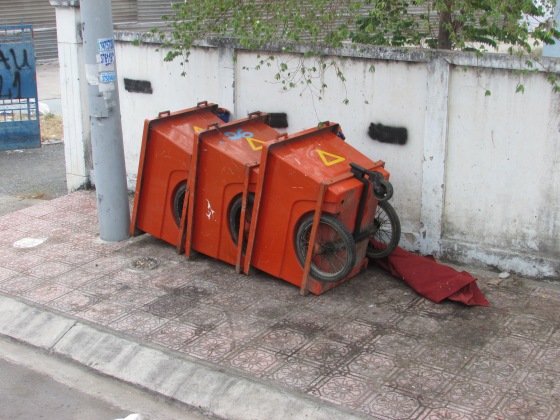Development of HCMC
The longer I live in Vietnam, the more I realize just how wonderful (in a good/bad sort of way) it is to be in a developing country. For our Environmental Science class, we toured the different canals around HCMC and were able to engage in a first hand learning experience how the garbage system works. At garbage stations around the city (there are around 17 but they need about 6 more to really be efficient) people pick through garbage by hand. Literally, outside of these smelly, unsafe, unsanitary areas. .. people do this to earn a little extra income. Most of them do this with their bare hands and have no masks/sanitary equipment. It’s the norm for HCMC but if that were the case in the states, well, it wouldn’t be. There is a much different sense of necessity here as well as means of what to do in order to merely survive. Seeing people do this is a very grounding experience. I wish everyone had the opportunity to see the lives of these people, maybe it would encourage them to be less wasteful and realize how they should take full advantage of the wonderful system America implements. America has its problems, sure. However, at least we have recycling and garbage treatment plants. We also found out that certain countries, such as the Netherlands and even the U.S., have paid for construction of more garbage stations around HCMC.
One of the most interesting things about these donations are that many people refuse the help. The treatment plants are built, of course, but the Netherlands have offered to do more than that. They have offered toilets to those without them. We might think it’s insane to not have a toilet but for those in more slum-like areas, they just dump everything in the water. It’s easier, more convenient. Trash/etc. is thrown out the window. Pretty much every kind of waste goes in the canals. WHY do people not realize how bad this is for their health and the health of the environment? For me, these were the most pressing questions that arose as we drove around the city. Why?
Slums in HCMC
First of all, it’s a matter of cost. Vietnam is a developing country and has little money to invest in advanced technology for waste management, recycling programs, etc. Also, in a city of 10 million people, everything is squished together. Therefore, the streets are very thin, more like alley ways. It’s impossible to get any sort of large garbage truck down such small streets. Instead, the alleys are cleaned by manual workers who have small carts and a broom. They go street by street and sweep up garbage.
Trash bins used to collect trash in narrow alleys
The largest problem, however, is awareness. Many Vietnamese have no idea how their actions affect their health and the environment. When they throw waste into the canals and on the banks, mosquitos and rats flourish. This leads to disease. Living in such unsanitary conditions is, in general, very harmful to their health. My environmental professor even told me people catch and eat fish out of the canals — as they don’t understand how eating the fish from such dirty conditions could be harmful.
In this way I have been intrigued by the waste management system of HCMC. It’s something I had never really considered before and without doubt, have taken advantage of. Development is such an important part of HCMC and becomes evident when you see slums and the conditions of living. It’s even stranger to see modern apartment buildings behind the slums.
Every day, I become more and more appreciative of this experience — it has been a month now and I think I’m finally starting to really settle in.

